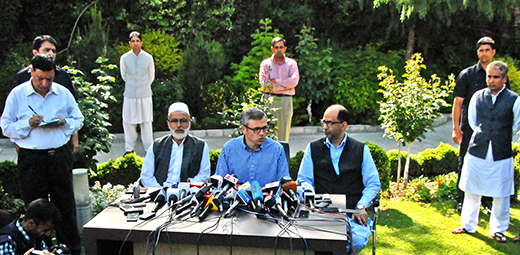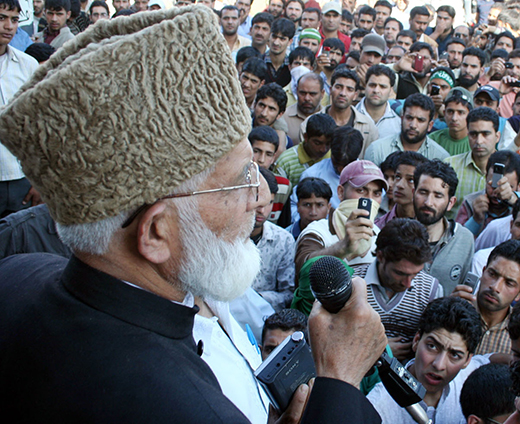Why NC lost the game and how the separatist boycott influenced the outcome, an analysis by Nazir Hussain

Pic: Bilal Bahadur
On May 7th after the last vote was polled in J&K, the National Conference issued an official statement. The following paragraphs from it are worth re-reading it:
“The people of North Kashmir have rejected PDP in the same manner in which PDP has been rejected in South Kashmir and Srinagar Parliamentary Seats.
PDP’s big balloon of rhetoric, lies and drama has imploded without a bang to reveal nothing but hollowness and pretension. The party’s tall claims have fallen flat and its candidates have been rejected from all three parliamentary seats in the Valley.
National Conference is conscious of the communal, anti-J&K intrigues that are going on at the behest of an unofficial, opportunistic alliance between BJP and PDP and that National Conference and its leaders would continue to protect the State’s special status from such external and internal foes.
PDP’s abjectly dismal performance in South Kashmir was the first step. PDP’s complete rejection in Srinagar was the second step. And today, PDP being emphatically rejected by the people of North Kashmir has announced the end and fragmentation of Mufti Mohammad Sayeed’s current party with unprecedented and unquestionable finality”.
Barely nine days later, National Conference, now that results have been announced, has lost all three seats in the valley! Its alliance partner, the Congress Party has lost the other three seats in the state, and how! In utter and abject humiliated.
Farooq Abdullah, the President of National Conference lost his Srinagar seat by a massive margin of 42,000 plus votes. So did Congress stalwart, Ghulam Nabi Azad with an equally embarrassing margin. Mehbooba Mufti won by a whopping 65,000 plus margin.
By the time the press release was issued there were no further voting to be done in J&K. So the pretext of beefing up the morale of the cadres and influencing the next phase could not have been the reason. The reasons lie elsewhere.
Why we are delving so much on the press release is because it gives an insight into the reasons why National Conference lost this election.
First, in the 400 odd word National Conference press release, PDP is mentioned ten times and NC only seven times! This shows the focus of NC as a political organization during the elections. They fought the election not on what they have done, can do or will do but on what PDP will do! Inadvertently, they fought the battle on PDPs terms and not their own. True they had nothing to offer in terms of local achievements so they shifted the debate to national level. But they carried it too far. This was a strategic mistake.
Second, what the press release goes to show is the complete disconnect with the people and grave ignorance about the political sentiment in the state. That is the real inference from the statement. Nine days before the results they talk of “PDP imploding and being decimated”. Obviously, they have no sense of what is happening on the ground. This is in part due to the fact that inexperienced and non-political people are calling the shots.
The third thing that the release shows is an obvious lack of political maturity. This is to some degree an extension of the second reason. Political inexperience of the coterie is written all over the release. When columns and opinions of individuals masquerade as press release, it shows the lack of institutional depth of a political party. It is sad that this should have happened to a party that is the oldest party of J&K.
Fourth, is NC tilting at the windmills? The NC did not speak about what it stood for but created a shibboleth as to what PDP stood for. This reflects ideological bankruptcy and absence of issues. To link Modi with Mufti was such juvenile thinking, especially after having been in bed with BJP, that no one bought it and it benefitted PDP. Mufti, brought all his maturity to the fore and not even once denied it! In doing so, he showed contempt for the thinking in the NC.
Be that as it may, what is the electoral arithmetic conveying? The separatists have hailed it as their victory as much as the mainstream political parties have. So where does the reality lie. As always, somewhere in between.
If low poll percentage is axiomatically taken to indicate a “boycott”, then a high voter turnout must also be interpreted to mean a rejection of the “boycott’’.
It makes no sense to go by aggregate numbers. Confining to the Valley, the two constituencies in Jammu and one in Ladakh saw very high turnout, out of the 45 assembly segments which constitute the three parliamentary constituencies, the top ten segments in the Valley had a poll percentage of 65 per cent. This is better than the all India level.
The next ten assembly segments show a poll percentage of 40 per cent. This is also hardly any affirmation of boycott. By normal standards this is a good and acceptable turnout. In the case of Kashmir, it is exceptional.
As such, nearly half of the assembly segments of the three parliamentary constituencies didn’t boycott the elections.

Pic: Bilal Bahadur
Of the remaining 25 assembly segment, ten have a poll percentage of 26 per cent. This can be interpreted either ways. For the remaining segments, the poll percentage is low at 14 per cent.
So, based on empirical evidence, the influence of separatists has now been squeezed to just 14 segments. On the obverse, a majority of the constituencies didn’t see a boycott, so what is Syed Ali Shah Geelani claiming a victory for?
If we go down further this path, out of these “boycott” segments, a new element which can be called the “sponsored boycott” has emerged. As any reporter who travelled across the Valley during the elections will testify, there was a “sponsored boycott” in many segments. These include Pulwama, Rajpora, Tral, Homshailbug, and Wachi.
Here as has been alleged by Prem Shankar Jha in his column in a local daily, the national Conference had engineered the boycott by using the JKLF cadres for some consideration or the other. This is now being scrutinized by a civil society group.
If that indeed is so, then boycotts are hardly ideological. There are more to do with electoral management. So too are the stone pelting on poll booths which are organized to dissuade voters.
The big away in this context was Chief Minister Omar Abdullah’s tweet taunting the secessionists. He tweeted “what is the point of issuing a poll boycott call, if you can’t terrorise people in to obeying it!! Clearly, NC saw boycott as a strategy of election management”.
Similarly, killing of sarpanches created a sense of fear and in segments like Pampore, the killing that happened days before the polling, kept voters inside.
As such, the ideological boycott, one that is a method of resistance, was confined to Sopore and Srinagar. The low voting in Sopore can be seen as in deference to the grand old man and Srinagar out of complete indifference.
If one gives up the boycott theory, and looks for reasons for the varying poll percentage, the answers are much more accurate and meaningful. Wherever there is a political context between two or more political parties, the poll percentage are high. Wherever there is a one party stronghold and there is no contest, the poll percentage is low.
Take the case of Noorabad. It is a NC stronghold in the PDP bastion. PDP this time made inroads into it and a genuine contest took place. The poll percentage crossed 70 per cent.
In Handwara, the presence of Peoples Conference and the existence of PDP and NC pushed up the vote 69 per cent. So too was the case in Kangan, Karna and Kupwara. In the case of Langate, with PDP, NC and Engineer Rashid in the play, the high poll percentage nearly touched 50 per cent.
Uri which has a strong NC, PDP and Congress presence, again the voting percentage to be a high of 65 per cent.
In good old political terms, what is happening is that there is political mobilization in these areas, political workers motivated and mobilize the voters to come out and vote.
In areas where there is no contest and it is a one sided affair, the workers efforts at mobilization is lax and the turnover is poor.
The moral of the story is that what is needed for high voter participation is political parties and options or choices.
It is not about the ideology of separatism. The ideology of separatism is there and will continue to be so, independent of the elections. It is about regular mainstream political context and contestation.
As a GK columnist pointed out recently, “As a strategy of resistance, the boycott of elections is meant to challenge the political process and structure. But as it is being conducted now, election boycott is not challenging the structure but influencing the outcome of elections. With this boycotts have been reduced to procedural arrangements of political parties. All that the election boycotts do now is to create political uncertainty rather than erode legitimacy as it used to”.















